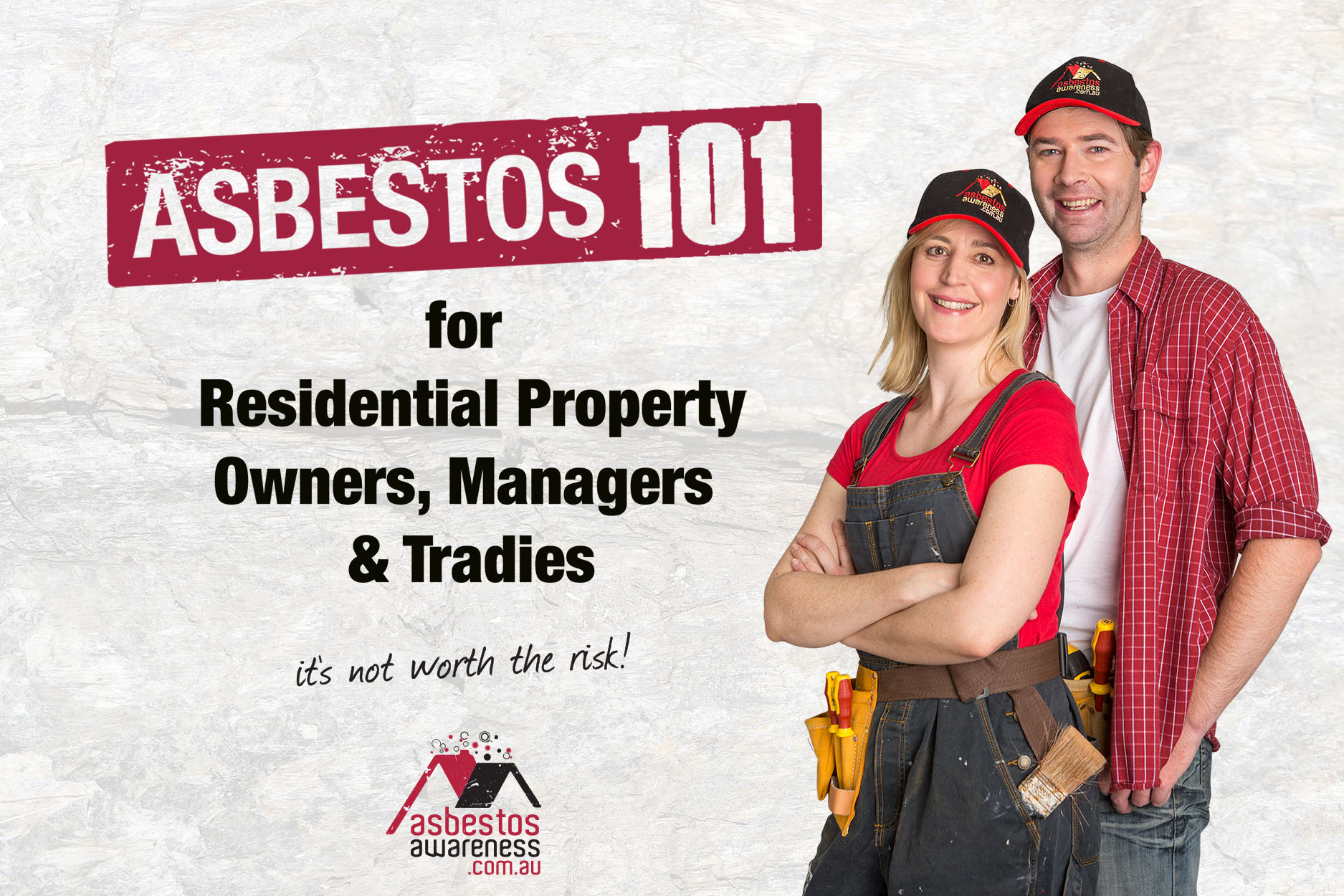
As Australia continues to face the significant health risks of asbestos-related diseases due to asbestos-containing materials (ACMs) remaining hidden in one third of Aussie homes, the Asbestos Education Committee and Advocacy Australia launched their 10th annual National Asbestos Awareness Month campaign with a new education resource, Asbestos 101 for Residential Property Owners, Managers and Tradies.
To help reduce the incidences of asbestos-related diseases, since 2011 the annual National Asbestos Awareness campaign has developed vital new resources to ensure Australians continue to learn to manage asbestos safely by providing user-friendly and often world-first resources at www.asbestosawareness.com.au
Clare Collins, Chair of the Asbestos Education Committee and Advocacy Australia said, “Having identified the need for this new, unique education resource for those most likely to come into contact with asbestos in residential properties (homeowners, renovators, property managers and tradies), the Asbestos Education Committee continues to increase community awareness by providing vital free resources to help save lives.”
“While Australia faces the serious wave of silicosis disease, a preventable occupational lung disease predominantly impacting workers from a wide range of industries; Australians must never forget that asbestos lurking in homes continues to pose serious health risks to anyone exposed to fibres when asbestos is not managed safely during renovations, maintenance or demolition including mums, dads and children.”
When asbestos is disturbed and microscopic fibres are released that can be inhaled, this can lead to asbestos-related diseases including asbestosis, lung cancer and malignant mesothelioma. There is no cure for mesothelioma, a cancer that can develop between 33 and 44 years after inhaling asbestos fibres with the average survival time following diagnosis around 12 months.
“There is no known safe level of exposure to asbestos fibres. With exposure now also linked to ovarian and laryngeal (voice box) cancers, and evidence suggesting it may increase the risk of other cancers such as breast, stomach and colon cancer, the importance of increasing awareness and community knowledge of asbestos risks, cannot be overstated,” Ms Collins said.
“With interest rates rising and a shortage of tradies putting pressure on homeowners to do their own renovations, we hold serious concerns that DIYers might risk their lives and the lives of loved ones if they fail to respect the life-threatening risks when asbestos is not managed safely and in line with regulations,” she said.
Many homeowners know little of asbestos risks and think that only tradies are at risk of asbestos-related diseases but the reality contradicts this thinking. According to the most recent Australian Mesothelioma Registry (AMR) Report (April 2023), 83% of respondents were assessed as having had ‘possible or probable’ exposure to asbestos fibres in non-occupational settings – primarily in homes.
Of the patients surveyed, the dominant non-occupational exposure to asbestos fibres (51%) occurred when undertaking major home renovations. 38% said they’d lived in a house undergoing renovations. 20% said they’d lived in the same home as someone who was exposed to asbestos at work and brought the fibres home in dust, while 12% said they’d lived in a house made of fibro that was built between 1947 and 1987.
With Australia’s annual asbestos-related death toll of more than 4,000 predicted to rise, the Asbestos Education Committee is urging homeowners, property managers and tradies to learn how to manage asbestos safely by visiting Australia’s leading source of asbestos information, www.asbestosawareness.com.au
The website contains an extensive range of free, user-friendly information for homeowners, property managers, renovators and tradies with the newly developed Asbestos 101 for Residential Property Owners, Managers and Tradies education resource developed for anyone who might do work on residential properties.
Developed in accordance with government Work Health and Safety Regulations and Codes of Practice, Asbestos 101 for Residential Property Owners, Managers and Tradies is a comprehensive resource that provides Australians with vital information as to why asbestos is dangerous; the risks of working unsafely with ACMs; the steps to take if they come across materials they suspect may contain asbestos; the importance of engaging an occupational hygienist or licenced asbestos assessor to confirm if asbestos is present; and, why it’s vital to only use licenced asbestos removalists to ensure hazardous asbestos materials are removed and disposed of safely in accordance with government regulations.
Cherie Barber, Australia’s Renovation Queen™, recognised as the foremost expert on renovating having featured on current affairs and lifestyle programs and in international media forums throughout her 30+ year award-winning career, has been an Asbestos Awareness Ambassador since 2013, dedicating her expertise, energy and resources to educating Australians about the dangers of asbestos.
“Australia was one of the highest consumers of ACMs globally which is why asbestos will remain an ever present danger embedded in every corner of Australian life for generations to come,” Ms Barber said.
Cherie, who lost her grandfather to asbestos-related disease said, “The only way we can help prevent deaths caused by asbestos exposure is to continue our campaign to increase awareness of the risks and ensure the community has access to vital information that just may save their life or the life of a loved one,” she said.
“For those who believe that only homes constructed from fibro sheeting are affected, they would be wrong. Before a complete ban in Australia (31 Dec 2003), asbestos fibres were incorporated in the manufacture of over 3000 building and decorator products used extensively in the construction of brick, weatherboard, clad homes, apartments and other residential property structures such as backyard sheds, fences and garages – It could be anywhere!”
“If undisturbed, well maintained and in a stable, sealed condition, these products are considered unlikely to pose health risks. However, if exposed to the elements and weathered (roofing or external walls), damaged or disturbed during renovations, maintenance, removal or during the demolition of homes and other structures (fences, sheds or garages) and microscopic fibres are released that can be inhaled, homeowners, renovators and tradies could be putting their lives and the lives of families at risk,” Ms Barber said.
“Complacency is a major contributing factor to avoidable exposure to deadly fibres. With asbestos-related deaths predicted to continue to rise as a result of renovating or maintaining homes built before 1990; it’s vital that homeowners and tradies learn to respect asbestos and take all the appropriate precautions including only using licenced professionals to identify and remove asbestos in accordance with regulations,” she said.
When it comes to asbestos, remember the DON’Ts! Don’t cut it! Don’t drill it! Don’t drop it! Don’t sand it! Don’t saw it! Don’t scrape it! Don’t scrub it! Don’t dismantle it! Don’t tip it! Don’t waterblast it! Don’t demolish it! And whatever you do… Don’t dump it! Visit asbestosawareness.com.au because it’s not worth the risk!
ENDS
NATIONAL ASBESTOS AWARENESS MONTH 2023
Marking 12 years campaigning in the prevention of asbestos-related diseases
2023 marks the 10th anniversary of National Asbestos Awareness Month and 12 years as Australia’s longest-running, multi-award winning annual asbestos education campaign warning homeowners, renovators and tradies of the dangers of asbestos and directing them to Australia’s most comprehensive source of asbestos information and resources at asbstosawareness.com.au where they can learn how to manage asbestos safely.
Since launching asbestosawareness.com.au in 2011 for Asbestos Awareness Week, the campaign has grown into National Asbestos Awareness Month winning multiple peer-reviewed awards both nationally (7) and internationally (2) and has been acknowledged in parliaments across Australia and global medical journals as a leading initiative in the prevention of asbestos-related diseases. In December 2022, Advocacy Australia was recognized with two Golden Target Awards for the 2021 campaign.
The importance of continuing the National Asbestos Awareness Month campaign and the asbestosawareness.com.au website in the prevention of asbestos-related diseases cannot be overstated. With funding for the campaign ceasing in 2018 and funding to keep the website live concluding in January 2019, to help save lives the campaign is being conducted in a pro-bono capacity. To continue the campaign and keep the website live beyond 2023, funding is desperately needed.
ASBESTOSAWARENESS.COM.AU
asbestosawareness.com.au is Australia’s leading, most comprehensive trusted source of asbestos information dedicated to educating the community about the dangers of asbestos with a specific focus on homeowners, renovators, tradies, commercial property managers and the owners and managers of regional properties where naturally occurring asbestos can be found.
Since launching on Monday 21 November 2011, the asbestosawareness.com.au website has had:
Over 2.5 million pageviews
- Over 1.1 million sessions
- Over 815,000 unique users
- Asbestos information resources accessed from the website:
- Over 1500 resources are available to the public to download. 107 are flyers, fact sheets, posters and templates with the remaining being images, graphics, presentations and videos.
- These resources have been accessed over 600,000 times
asbestosawareness.com.au, provides comprehensive asbestos information and user-friendly practical resources:
- Asbestos 101 for Residential Property Owners, Managers and Tradies (Education resource)
- Asbestos in Your Home – The Ultimate Renovators Guide (Easy to follow video hosted and produced by Australia’s Renovation Queen™ and Asbestos Awareness Ambassador, Cherie Barber)
- Asbestos Awareness Residential Property Checklist – A Homeowner’s Guide to Identifying Asbestos-Containing Materials (User-friendly step-by-step guide to identifying asbestos in the home)
- Asbestos Awareness – 20 Point Safety Check (Asbestos risks and how to manage asbestos safely)
- Fact Sheets for Homeowners (When, why and how to use Personal Protective Equipment (PPE))
- Asbestos Awareness Toolbox Talks (10 Toolbox Talks to help employers better inform workers of asbestos risks )
- Asbestos Awareness for Young Workers (Education resource developed with SafeWork NSW )
- Asbestos Awareness – 20 Point Safety Check (Asbestos risks and how to manage asbestos safely)
- Residential Checklist for Tradies – A Tradespersons Guide to Asbestos (Identify the product types and locations)
- Trade Specific Checklist for Tradies – A Tradespersons Guide to Asbestos (Tailored to 23 specific trades)
- Fact Sheets for Tradies (When, why and how to use Personal Protective Equipment (PPE)
- Asbestos Product Database (Australia’s first comprehensive online asbestos product database)
- Asbestos Management for Commercial and Non-Residential Properties (Australia’s only online resource)
- Naturally Occurring Asbestos – Asbestos Management Plan Guide (Australia’s only free online resource)





